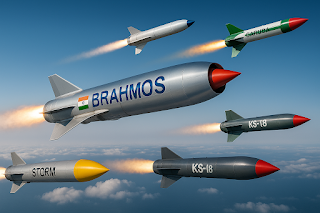Introduction
Supersonic missiles, capable of flying between Mach 1 and Mach 5, continue to dominate modern warfare with their speed, precision, and survivability. Unlike slower cruise missiles or expensive hypersonic systems, supersonic missiles strike a balance between affordability and impact. This article presents the top 10 supersonic missiles as of 2025, based on available public data regarding their speed, range, platform flexibility, and combat deployment. These are the operational systems reshaping naval and aerial tactics across the globe.
Missile Overview
BrahMos (India–Russia)
Speed: Mach 2.8–3.5
Range: 500–800 km (upgraded version)
Platform: Land, Sea, Air, Submarine
Details: Developed by DRDO (India) and NPO Mashinostroyenia (Russia), BrahMos is a ramjet-powered cruise missile for anti-ship and land-attack roles. Deployed by Indian Armed Forces and exported to the Philippines in 2022.
Related Articles To Read More (click)
3M-54 Kalibr (Russia)
Speed: Mach 2.9–3 (terminal phase)
Range: 200–4,500 km
Platform: Ship, Submarine
Details: Anti-ship variants feature a supersonic terminal sprint. Used in Syria (2015–2018) and Ukraine (2022–2025), with conventional or nuclear warheads.
P-800 Oniks/Yakhont (Russia)
Speed: Mach 2.5–3
Range: 300–600 km
Platform: Ship, Coastal, Air
Details: A ramjet-powered anti-ship missile, used by Russia and exported to Vietnam and Syria. Basis for BrahMos.
Kh-31 (Russia)
Speed: Mach 2.7–3.5
Range: 70–250 km
Platform: Air-launched
Details: Features anti-ship (Kh-31A) and anti-radar (Kh-31P) variants, used by Russia and India for high-speed strikes.
CM-302/YJ-12 (China)
Speed: Mach 2–3
Range: 280–400 km
Platform: Land, Ship, Air
Details: Export version of YJ-12, developed by CASIC. Used for anti-ship and land-attack roles, exported to Pakistan.
ASM-3 (Japan)
Speed: Mach 3
Range: Not publicly disclosed
Platform: Air-launched
Details: Developed by Mitsubishi Heavy Industries, deployed by Japan’s Air Self-Defense Force for anti-ship roles.
Hsiung Feng III (Taiwan)
Speed: Mach 2–2.5
Range: 130–400 km
Platform: Ship, Coastal
Details: Taiwan’s indigenous supersonic anti-ship missile, deployed for coastal defense.
RBS-15 (Sweden)
Speed: Mach 1.5–2
Range: 200–300 km
Platform: Ship, Coastal, Air
Details: Developed by Saab, used by Sweden and allied navies. Modern variants reach low supersonic speeds.
SS-N-22 Sunburn (Moskit) (Russia)
Speed: Mach 2.5–3
Range: 120–250 km
Platform: Ship, Coastal
Details: Soviet-era ramjet-powered anti-ship missile, operational in Russia and China.
C-802/YJ-83 (China)
Speed: Mach 1.5–2 (upgraded variants)
Range: 120–180 km
Platform: Ship, Coastal, Air
Details: Turbojet-powered anti-ship missile, exported to Pakistan and Iran. Supersonic in specific variants.
AGM-88 HARM / AARGM-ER (USA)
Speed: Mach 2+
Range: ~150 km (HARM), 300+ km (AARGM-ER)
Platform: Air-launched (F-16, F/A-18, F-35)
Details: Used for Suppression of Enemy Air Defenses (SEAD) by targeting enemy radar systems. Widely deployed by U.S. and NATO forces.
SM-6 (USA)
Speed: Mach 3.5
Range: ~240–460 km
Platform: Ship-launched (U.S. Navy Aegis ships)
Details: Originally a surface-to-air missile, the SM-6 now has anti-ship strike capability, making it a rare dual-role supersonic missile with both offensive and defensive functions.
Why Supersonic Missiles Matter
Supersonic missiles (Mach 1–5) are fast, precise, and difficult to intercept, making them critical for naval, air, and land-based strike capabilities. They are more cost-effective than hypersonic systems and form the backbone of many nations’ defense strategies.
Comparison Table
| Missile | Speed (Mach) | Range (km) | Platform | Country |
|---|---|---|---|---|
| BrahMos | 2.8–3.5 | 500–800 | Land, Sea, Air, Sub | India–Russia |
| 3M-54 Kalibr | 2.9–3 | 200–4,500 | Ship, Sub | Russia |
| P-800 Oniks | 2.5–3 | 300–600 | Ship, Air, Coastal | Russia |
| Kh-31 | 2.7–3.5 | 70–250 | Air | Russia |
| CM-302 | 2–3 | 280–400 | Land, Ship, Air | China |
| ASM-3 | 3 | Not disclosed | Air | Japan |
| Hsiung Feng III | 2–2.5 | 130–400 | Ship, Coastal | Taiwan |
| RBS-15 | 1.5–2 | 200–300 | Ship, Air, Coastal | Sweden |
| SS-N-22 Sunburn | 2.5–3 | 120–250 | Ship, Coastal | Russia |
| C-802/YJ-83 | 1.5–2 | 120–180 | Ship, Air, Coastal | China |
Conclusion
This list highlights the top operational supersonic missiles in 2025, combining speed, range, and strategic impact. From India’s BrahMos to C-802/YJ-83, these systems shape modern warfare and remain essential to 21st-century defense doctrines.
💬 What Do You Think?
Which supersonic missile do you believe is the most powerful or game-changing in 2025? Do you think supersonic tech still has an edge over hypersonics?
Share your thoughts in the comments below!


No comments:
Post a Comment
We’d love to hear your thoughts! Please keep your comments respectful and relevant.